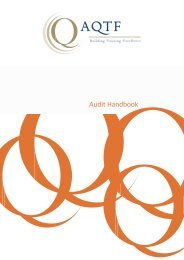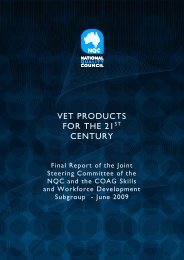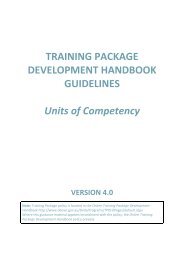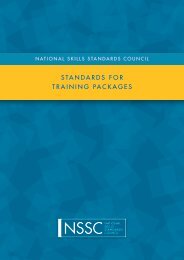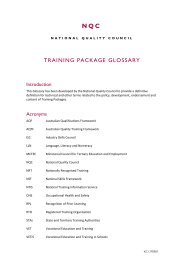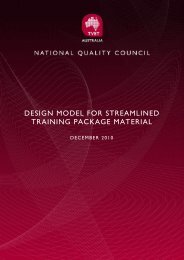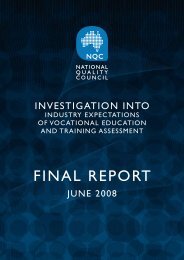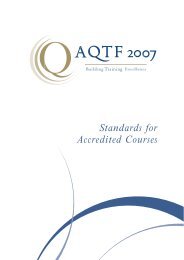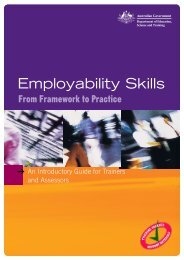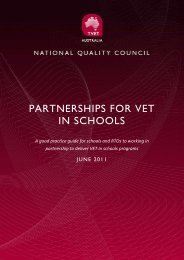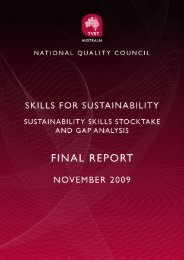Guide for Developing Assessment Tools - National Skills Standards ...
Guide for Developing Assessment Tools - National Skills Standards ...
Guide for Developing Assessment Tools - National Skills Standards ...
- No tags were found...
You also want an ePaper? Increase the reach of your titles
YUMPU automatically turns print PDFs into web optimized ePapers that Google loves.
NQC | <strong>Guide</strong> <strong>for</strong> developing assessment tools2.3 PRODUCT BASED METHODS(e.g. Reports, Displays, Work Samples.)Table 4: Product Based Methods: Exemplar <strong>Assessment</strong> Tool Features.Component Feature Generic applicationThe context The purpose and target The target group is XXX candidates undertaking the Certificate ofgroup should be described XXX. The candidate should be able to demonstrate evidencewithin the boundaries of their workplace context. Evidence can becollected either on and/or off the job. The tool has been designedto be used to assess candidate’s competency acquisition followingtraining (e.g. summative) and/or may be used to demonstraterecognition of current competency. This tool assists with assessingthe candidate’s ability to apply skills and knowledge and will needto be assessed in conjunction with XXX (e.g. interview) to ensureadequate coverage of the entire unit of competency.Competency Map key components of Each key component of the activity should be mapped to theMapping task to the Units(s) of relevant sections within the Unit of Competency. For example, ifCompetency (content the task is to produce a policy document, each key feature to bevalidity) – refer toincluded in the policy document should be mapped to the Unit ofTemplate A.2Competency. This will help to determine the sufficiency of theevidence to be collected and determine whether any other aspectsof the Unit(s) of Competency need to be collected elsewhere.In<strong>for</strong>mation to Outline the task to be The instructions <strong>for</strong> building/creating the product need to be clearlycandidate provided to the candidate specified and preferably provided to the candidate in writing priorthat will provide the to <strong>for</strong>mal assessment. The evidence criteria to be applied to theopportunity <strong>for</strong> theproduct should also be clearly specified and communicatedcandidate to demonstrate (preferably in writing) to the candidate prior to the commencementthe competency. It should of the <strong>for</strong>mal assessment.prompt them to say, do,write or create something. Details about the conditions of the assessment should also becommunicated to the candidate as part of these instructions (e.g.access to equipment/resources, time restrictions, due date etc)Evidence from Provides in<strong>for</strong>mation on The tool needs to specify whether the product only will becandidate the evidence to be assessed, or whether it will also include the process. If it isproduced by the candidate product based assessment only, then the candidate needs to bein response to the task. instructed on what to include in the product. The conditions <strong>for</strong>producing the product should be clearly specified in the‘in<strong>for</strong>mation to be provided to the candidate’; which will directlyinfluence the type of response to be produced by the candidate(e.g. whether they are to draw a design, produce a written policy document, build a roof etc). If the Tool also incorporates assessing the process of building the product, then the observations of the process would need to be also judged and recorded (refer to the Tool Characteristic – Observation Methods<strong>for</strong> guidance). In relation to product based assessment only, the candidate would need to be instructed on how to present his/her product <strong>for</strong> example: Portfolio (possibly containing written documents, photos, videos etc); Display or exhibition of work; and Written document etc. Decision The rules to be used to: This section should outline the procedures <strong>for</strong> checking themaking rules check evidence appropriateness and trustworthiness of the product evidence suchquality (i.e. the rules as its:of evidence);Currency - is the product relatively recent. The rules <strong>for</strong>judge how well the determining currency would need to be specified here (e.g.candidate per<strong>for</strong>med less than five years);according to theAuthenticity - is there evidence included within the productstandard expected that verifies that the product has been produced by the(i.e. the evidencecandidate and/or if part of a team contribution, what aspectscriteria); andwere specific to the candidate (e.g. testimonial statementssynthesise evidence from colleagues); andfrom multiple sources Sufficiency - is there enough evidence to demonstrate to theto make an overall assessor competence against the entire Unit of Competency,judgement.including the critical aspects of evidence described in theEvidence <strong>Guide</strong> (e.g. evidence of consistency of per<strong>for</strong>manceGUIDE FOR DEVELOPING ASSESSMENT TOOLS PAGE 13



